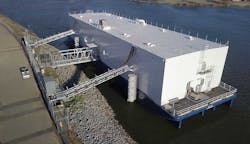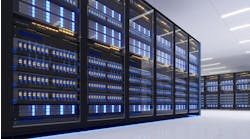Backblaze Extends its Storage Cloud to the Nautilus Floating Data Center
Backblaze is extending its cloud storage platform to a water-based data center in California, the company said today. Backblaze will deploy 1 megawatt of capacity at the Nautilus Data Technologies facility in Stockton, California, which operates on the San Joaquin River.
The customer win is an important milestone for Nautilus Data Technologies, which operates water-cooled data centers that tap rivers, lakes and oceans to slash the cost of cooling servers. The Nautilus design uses prefabricated data modules and a water-cooled rear-door cooling unit, a combination that offers exceptional energy efficiency. The company has the ability to deploy capacity on water or land.
Last year Nautilus opened its first site in the Port of Stockton with a 7-megawatt data vessel. Nautilus has said the site has a handful of customers, but Backblaze is the first to be publicly announced.
“We are excited to have Backblaze on board,” said Rob Pfleging, CEO of Nautilus. “We can help foster their growth in a sustainable way. With our data center solutions focused on advanced cooling and power efficiency, Backblaze will not only be able to reduce their environmental impact but also lower their total cost of ownership, all while continuing to meet the high demands of their growing customer base.”
Water-Cooled Expansion for Backblaze
Backblaze is an independent data storage service provider with more than 500,000 customers in 175 countries, and became a public company through an IPO last year. Founded in 2007, the company offers computer backup for personal computers as well as its developer-focused B2 Cloud Storage “as a service” platform.
Backblaze is known for its open source Storage Pod design that can house 60 14-terabyte drives. During the 2012 global shortage of hard drives, Backblaze organized a “drive farming” expedition in which the company deployed employees, friends and family to acquire drives from retail stores in the Bay Area. The company operates from data centers in Phoenix, Amsterdam and Sacramento, Calif. – and now Stockton.
“We are challenging some of the world’s biggest technology companies with Backblaze B2 Cloud Storage and Computer Backup, so efficiency and innovation are central to our success,” said Gleb Budman, CEO of Backblaze. “Working with Nautilus is exciting because they are clearly committed to these same ideals. Committing to this new data center is exciting for us because we can both invest in a sustainable future for data storage while also furthering our goals to provide astonishingly easy, affordable, and scalable cloud solutions to our customers.”
New Leadership for Nautilus
Although the Stockton facility is water-based, Nautilus used a land-based design for its second project, a $300 million data center project in Maine that taps a reservoir to create a gravity-fed cooling system for high performance computing. The Maine facility will use the topography of a former paper mill in Millinocket in a gravity-fed design that reduces the need to use energy for pumps.
Going forward, Nautilus will expand its business to target top tier markets, as well as second-tier cities, and will also deploy dedicated data centers for our customers.
Nautilus believes that efficiency goes beyond power, and that water management is critically important for future data centers. The company expects to deliver a PUE (Power Usage Effectiveness) of 1.15 or lower, a range typical of the largest hyperscale operators.
In early projects, Nautilus has used a rear-door cooling unit that can support unusual density, allowing customers to get more data center capacity per square foot of real estate. Nautilus says its water cooling system can support workloads at up to 100 kilowatts a rack, compared to the current average of about 8 kW per rack. That enables new deployment footprints for high-performance computing (HPC) uses like AI, as well as applications for remote learning and other high-density applications.
Nautilus has also begun supporting immersion cooling and direct-to-chip liquid cooling, and can also support clients who desire high-density air cooling.
Rob Pfleging, the new Chief Executive Officer at Nautilus Data Technologies, (Photo: Nautilus)
Nautilus recently underwent a leadership transition, as Pfleging was elevated to the CEO roles, succeeding industry veteran James Connaughton, who will remain with Nautilus as its board chair.
“Nautilus set out on a specific mission to unleash computing performance with the smallest environmental footprint for the greatest social gain globally,” said Connaughton. “We have proven that mission is achievable with breakthrough innovations in data center architecture, engineering, construction, and operation validated by the successful commissioning of our first commercial scale data center, onboarding of leading customers, and partnership with a growing network of international suppliers and developers. Following two years of operational success as company President, Rob is the ideal leader to take us forward and deliver on this mission globally.”
Pfleging’s experience spans two decades in the data center industry. He was pivotal in growing Vertiv’s data center infrastructure business worldwide as the Senior Vice President of Global Solutions, one of the company’s most prominent business units. Before Vertiv, he was responsible for 55 global data centers at CenturyLink. His experience includes leadership roles at Mercy, Schneider Electric, APC, and the United States Marine Corps.
“For the last two decades, I’ve built data centers striving for greater efficiency with each project but only achieving incremental improvements,” said Pfleging. “But Nautilus’ combination of data center delivery and water-cooling technology allows us to set unparalleled benchmarks for efficiency, performance, and sustainability. With our build and cooling innovations, we’re in a unique position to help organizations integrate their need for sustainability and their need to deploy new data center capacity faster than ever before. I look forward to helping transform the industry to a more sustainable future.”






